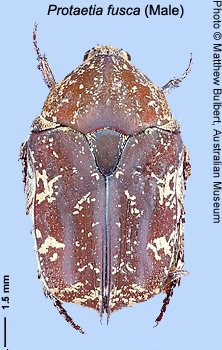
Protaetia fusca (Herbst)

|

|
|
Diagnostic description |
|
|
Length |
12-15 mm |
|
Colour |
Dorsum various shades of brown or reddish-brown, sometimes mottled, apex of scutellum often darkened, pronotum often lighter than elytra, with small spots and flecks of white or creamy-white dense microtrichiae; microtrichial patches speckled over much of surface, not forming discrete patches or spots; mesoventrite process dark; upper surface dull. |
|
Head |
Clypeal margin truncate; densely and strongly punctured and entirely setose (often worn off clypeus); antennal club as long as or slightly shorter than remaining segments. |
|
Pronotum |
Lateral margins almost evenly rounded towards anterior; sparsely and finely punctured with short setae at sides of disc (midline smooth), more densely punctate and setose at anterior and lateral margins; basal margin arcuate at junction with scutellum. |
|
Scutellum |
Elongate-triangular, with blunt rounded apex; glabrous and smooth except densely punctate and setose basal angles. |
|
Elytra |
Disc with 1-4 irregular longitudinal grooves, otherwise almost impuncate, sides and apex with dense C-shaped punctures and transverse wrinkles; glabrous or short thick setae present at sides; scutellar groove absent; apical half of suture strongly raised, keeled, and produced at apex of suture; humeri not prominent, but elytral margins slightly sinuate. |
|
Mesoventrite process |
Strongly transverse, not projecting, anterior margin slightly curved, impunctate or with a few small punctures and glabrous. |
|
Abdomen |
All ventrites with scattered thick scale-like setae and U-shaped punctures in both sexes. |
|
Legs |
Fore tibia with 2-3 sharp teeth on external edge (basal tooth often absent in males); claws symmetrical; posterolateral corner of hind coxa moderately to strongly produced, apical angle 45-90 degrees; hind femur straight, not lobed on ventral edge; hind tibia thinner than femur, straight, expanded at apex, with small median tooth and internal fringe of long setae; hind tibial spurs thin and sharp in both sexes. |
|
Sexual dimorphism |
||
|
|
Male |
Female |
|
Sutural angle |
Strongly produced as a sharp spine, apical angle much less than 45 degrees. |
Slightly produced, triangular, apical angle 45-60 degrees. |
Distribution and biology: Protaetia fusca is common in Australia, from central NSW to north QLD and the NT, but also occurs in Mauritius, India, south-east Asia, China and Hawai'i. It occurs from the east coast as far west as Cobar, NSW. It has been dispersed by humans and records for Mauritius, Japan, Fiji and Hawai'i are due to accidental introductions. Larvae live in compost and are therefore easily transported.
In Australia, adults are active from September to May. Adults are pests and have been recorded feeding on avocado, citrus, fig, flowering peach and rose in Australia. Elsewhere they have been recorded from cassia, coconut, ginger and mango. They cause structural damage by snipping off apical shoots to drink sap. Adults have also been recorded infesting bee-hives and stingless bee nests (Lea 1914; Anon 1950).
The larvae feed on dead plant material, including compost, cotton mulch, goat faeces and sugar mill refuse (Simpson 1990). They may cause root damage (Arrow 1910). Larvae are considered beneficial as they convert mulch to soil. In Australia they are parasitised by a scoliid wasp. The larva and pupa have been described (Simpson 1990).
References: Arrow 1910, Lea 1914, Sakimura 1950, Anon. 1950, Kusui 1980, Simpson 1990; Cassis & Weir 1992, Allard 1995.
